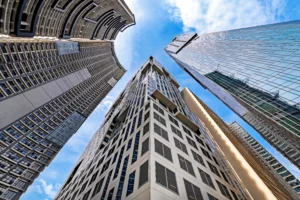MANILA – Sweating under their hard hats, renowned Polish architect Daniel Libeskind and interior designers from Italy’s Armani trooped to a construction site in sweltering, downtown Manila, to perform the ground breaking for a new tower in the Philippine capital.
Marketed to attract buyers wealthy enough to own luxury apartments, most likely in more than one country, the 60-storey office and residential project, dubbed “Century Spire”, is being built in the downtown Makati district.
Featuring an angular glass shaft with an asymmetrical triple summit, the “Spire” is due to be completed in four years, but two-thirds of the space is already sold, with many of the apartments taken by rich Asians living elsewhere in the region.
At the ground breaking ceremony in May, Libeskind – whose other landmark buildings include the Jewish Museum in Berlin and the Denver Art Museum – said the “Spire” would “make a bold and optimistic statement about the future of the Philippines.”
Manila’s changing skyline reflects the Philippines’s increasing wealth, with many similarly stylised high-rises sprouting up across the capital of a country that was once regarded as one of the region’s economic basket cases.
Yield-hungry investors from Malaysia to Japan now buy Philippine condominium space in bulk, rotating money from favourites Hong Kong and Singapore as the authorities there have acted to cool real еstatе prices, property managers and consultants said.
“There has never been this strong foreign interest in the Philippines,” said David Young, Philippines managing director with consultancy and brokerage Colliers International.
Typically, 40 percent of space in newer condominiums is owned by foreigners, the maximum they are allowed. Foreigners cannot own land in the Philippines, but they are allowed to hold condominium titles as long as 60 percent of the development’s total floor area is owned by Filipinos.
“The fact that you have all these developers maximising the foreign limit is becoming very common,” said David Leechiu, Philippines country manager with property manager and advisory Jones Lang LaSalle Inc.
He said foreigners buy into Manila’s gleaming new towers for capital gains, or to rent to a growing Filipino middle class and expatriate population.
BUBBLE TALKS BUT STEADY YIELDS
Rising prices and the influx of foreign money has sowed fears of an asset bubble, but there are no signs of a slowdown. Rеal еstatе prices are still below rates seen before the global financial crisis despite a steady increase, brokers say.
In revising rules to banks’ real еstatе exposure this month, the central bank maintained that there is “no clear evidence” of bubbles forming in the sector.
Only as a precaution were banks told to maintain higher capital buffers if they want to lend more for real еstatе purposes, the central bank said.
With supply steadily meeting demand, property investors and brokers remain bullish.
Manila’s condominiums offer yields between seven to nine percent, nearly double those in most other Asian cities, a premium seen lasting for at least five more years, brokers say.
Residential condominium rent in the main business districts on average rose around 5 percent annually in recent quarters, while office rent is up over 5 percent, Colliers data showed.
A report by the U.S.-based Urban Land Institute and PricewaterhouseCoopers ranked Manila as fourth best in Asia-Pacific for property investments this year after Tokyo, Shanghai and Jakarta, saying operating cash flow returns in the Philippine capital could be in the mid-teens.
STOKING SALES
Rich Singaporeans, Chinese, Japanese, Koreans and Malaysians bought the most condominiums among foreigners in the past 18 months, officials from developers Ayala Land Inc, Megaworld Corp, and Century Properties Group Inc (CPG) told Reuters.
“Purchase levels can go from one unit to a couple of floors,” said Jaime Ayala, chief finance officer at Ayala Land.
Jericho Go, first vice president with Megaworld, said foreigners “buy residential condominium units in bulk, while others group together and pool funds to buy a tower in a development.”
Aided by strong foreign demand, domestic developers have enjoyed bumper sales in recent quarters.
Ayala Land, the second most valuable listed property firm, has increased international sales- including purchases by Filipinos living overseas – by 64 percent year-on-year in 2013, the company disclosed to Reuters.
Megaworld’s international sales were up 52 percent last year, while “Century Spire” developer CPG’s overseas sales increased 15 percent, Reuters estimated from sales data released by the two companies.
BUYERS AND SELLERS
Asians usually buy apartments worth as much as $550,000 per unit, CPG managing director Robbie Antonio said.
Brokers also noted rising interest in office space on bets that commercial leasing prices will skyrocket as more foreign firms outsource in the country.
The action remains concentrated in Manila, brokers said, although it is slowly spilling over into “new wave cities” in central and southern Philippines, which host business process outsourcing firms.
Top property developers use globally-known luxury brands to attract overseas demand.
Other than Armani, CPG has tapped Versace and American socialite Paris Hilton to design interiors. “Brand associations have attracted interest from foreign nationals,” Antonio said.
Ayala’s Ysmael said they continue to open sales offices overseas and is rolling out a Tokyo hub “soon.”
For their part, Megaworld’s Go said the company is offering in-house brokerage services to help in leasing apartments.
The surge in overseas pre-sales also keeps top property firms awash with cash to fund projects and fatten their land bank.
Jones Lang’s Leechiu said top developers brush off private equity and sovereign wealth funds seeking discounts as they forsee sustained strong demand from retail buyers.
“If they ask for too much discount we won’t agree. We don’t need the money,” Go said.
Source: ABS CBN News | July 2, 2014





